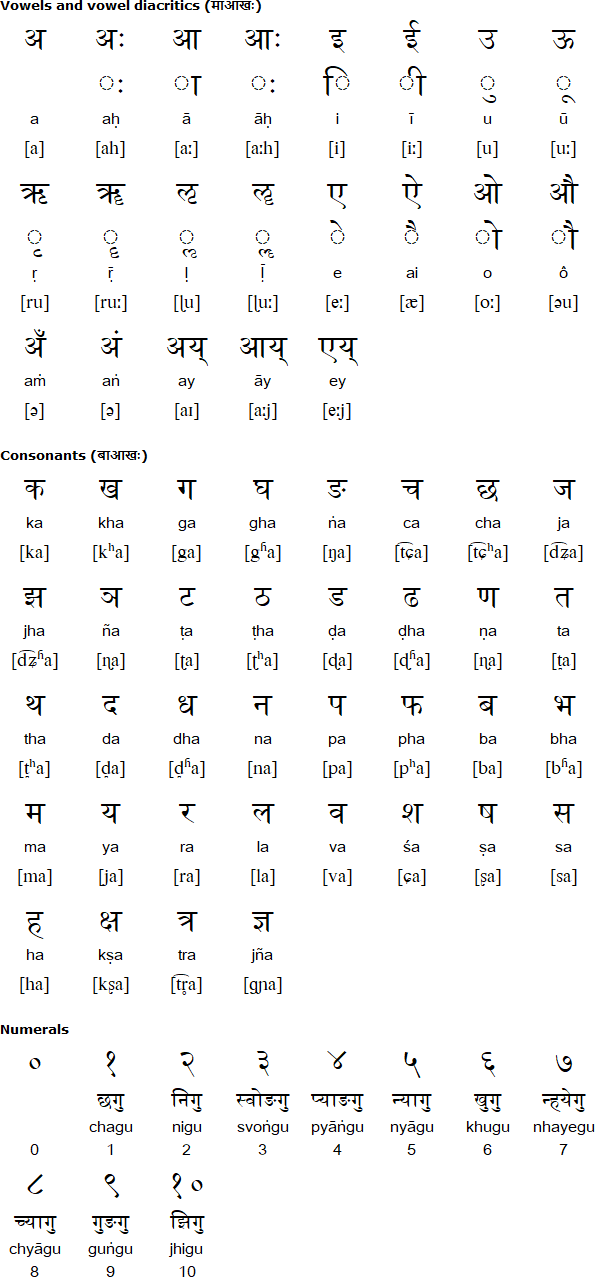Newar is a member of the Central Himalayan branch of the Tibeto-Burman language family. It is spoken mainly in the Kathmandu Valley in the Bagmati zone of Nepal. In 2011 there were about 879,600 speakers of Newar in Nepal. There are also about 14,000 speakers of Newar in northern India, mainly in Bihar, Sikkim and West Bengal states, and a few in Khasa (Dram / Zhangmu) a town in Tibet on the border with Nepal.
Newar is also known as Newari, Nepal Bhasa (Nepal language), Newa Bhaye, Newaah Bhaae, Newaah Bhaaye, Newah or Newal Bhaye. In Nepal it is taught in schools, used in the media and literature, and has official status in Kathmandu Metropolitan City.
Newar words first appeared in writing in Sanskrit texts during the 5th century AD. Texts in Newar started to appear in the 12th century, written on palm-leaf manuscripts in the Nepal Lipi (Nepal Script). Newar became an administrative language in the 14th century, and was used on public notices, stone inscriptions, and in books. Much literature in Newar was produced between the early 16th and the mid-19th centuries, including poetry, stories and dramas. The language was also used in official and religious texts. Since 1847, however, use of Newar in writing has declined, and at times it has been officially disapproved of and efforts have been made to abolish its use. There was oppoisition to this, and those who published in Newar risked imprisionment at times.
After democracy was established in Nepal in 1951, restrcitions on the use of Newar were removed. Many books, magazines and newspapers in Newar were published, and the language was used in schools and colleges.
In 1960, however, democracy fizzled out, and languages other than Nepali were suppressed. Use of Newar on the radio was banned, and its use was discouraged in schools. After 1990 use of Newar, and other languages, in literature, education and the media began to increase.
Newar is generally written with the Devanagari script nowadays. The Newa (Prachalit Nepal) script is also used to some extent. In the past it was written with Nepal Lipi (Nepal script), Ranjana script, and a number of other scripts.

In Newar various classfiers are attached to numbers depending on what is being counted. The numbers above have the classifier for objects (gu). Other classifiers include: mha for living beings, nhu for days and kha for time [more information].
Hear some numbers in Newar
सकलें मनूत स्वतन्त्र व ज्वलिज्वः आत्मसम्मान व वां दइकथं बुइ । इपिं स्वविवेक व सद्बुद्धि दयाः विवेकशील जुइ अले थवंथवय् दाजुकिजाकथं हनाबना याइ ।
All human beings are born free and equal in dignity and rights. They are endowed with reason and conscience and should act towards one another in a spirit of brotherhood.
(Article 1 of the Universal Declaration of Human Rights)
Details provided by Biswajit Mandal (biswajitmandal[dot]bm90[at]gmail[dot]com)
Information about Newar | Phrases | Ranjana script | Newa script (Prachalit Nepal)
Information about Newar
https://en.wikipedia.org/wiki/Newar_language
https://www.ethnologue.com/language/new
Online Nepal Bhasa lessons, dictionary and other resources
http://nepalbhasa.co.cc
Online Newari dictionary
http://glosbe.com/en/new/
Online Newari phrases
http://nepaliaustralian.com/tag/learn-basic-newari/
http://wronglart.blogspot.co.uk/2013/06/newari-dictionary-some-newari-words-and.html
Newari fonts
http://www.easynepalityping.com/newari-fonts-download
Sandhya Times - online Newari newspaper
http://www.nepalnews.com.np/sandyatimes.htm
Arakanese, Balti, Chocha Ngacha, Drung, Hajong, Hmar, Jingpho, Lepcha, Lhao Vo, Lhomi, Magar, Manipuri, Mro, Naxi, Newar, Pahari, Tangkhul Naga, Tujia, Yolmo
Aka-Jeru, Angika, Athpare, Avestan, Awadhi, Bahing, Balti, Bantawa, Belhare, Bhili, Bhumij, Bilaspuri, Bodo, Bhojpuri, Braj, Car, Chamling, Chhantyal, Chhattisgarhi, Chambeali, Danwar, Dhatki, Dhimal, Dhundari, Digaro Mishmi, Dogri, Doteli, Gaddi, Garhwali, Gondi, Gurung, Halbi, Haryanvi, Hill Miri, Hindi, Ho, Jarawa, Jaunsari, Jirel, Jumli, Kagate, Kannauji, Kham, Kangri, Kashmiri, Khaling, Khandeshi, Kharia, Khortha, Korku, Konkani, Kullui, Kumaoni, Kurmali, Kurukh, Kusunda, Lambadi, Limbu, Lhomi, Lhowa, Magahi, Magar, Mahasu Pahari, Maithili, Maldivian, Malto, Mandeali, Marathi, Marwari, Mewari, Mundari, Nancowry. Newar, Nepali, Nimadi, Nishi, Onge, Pahari, Pali, Pangwali, Rajasthani, Rajbanshi, Rangpuri, Sadri, Sanskrit, Santali, Saraiki, Sirmauri, Sherpa, Shina, Sindhi, Sunwar, Sylheti, Tamang, Thakali, Thangmi, Wambule, Wancho, Yakkha, Yolmo
Page last modified: 23.04.21
[top]
You can support this site by Buying Me A Coffee, and if you like what you see on this page, you can use the buttons below to share it with people you know.

If you like this site and find it useful, you can support it by making a donation via PayPal or Patreon, or by contributing in other ways. Omniglot is how I make my living.
Note: all links on this site to Amazon.com, Amazon.co.uk
and Amazon.fr
are affiliate links. This means I earn a commission if you click on any of them and buy something. So by clicking on these links you can help to support this site.
[top]